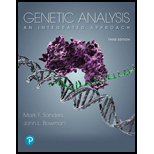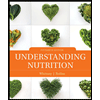
Genetics affects many aspects of our lives. Identify three ways genetics affects your life or the life of a family member or friend. The effects can be regularly encountered or can be one time only or occasional.
To review:
Three major affects of genetics on our lives or the lives of a family member or friend. Whether these genetic effects are encountered regularly or occur once or occasional.
Introduction:
Genetics is the branch of biology that is concerned with the study of heredity, genes and genetic variation in organisms. Mechanism of trait inheritance and molecular inheritance of genes are considered as the primary principles of genetics in 21st century. The study of gene structure, function, variation and distribution plays a vital role in everyday life of human beings. Genetics in combination with organism’s environment influence the development and behaviour of the organism.
Explanation of Solution
The genetic information present in DNA is organised in a large number of specific coded instructions called as genes. This genetic information, affects our day to day life by a number of ways. The physical appearance of the people such as the eye colour, texture of the hair and many other features depends upon the genetic structure of the organism. Genetics also determine the pattern of some diseases and conditions that run in the families. Thus it can help in understanding the risk of passing the disease on to their children by knowing the family history or pedigree of the disease. Health care professionals uses genetics for the identification of certain conditions in the babies before they born, by using techniques such as prenatal testing. The studies based on human families have indicated that overall variation in adult lifespan (approximately 20-30%) is accounted by genetic factors.
The type of genetic effect will determine whether it will encounter regularly or occur one time or occasionally. For example, the physical appearance of a person is a type of genetic effect that encountered regularly whiles the occurrence of genetic disease seen occasionally.
Thus it is concluded that physical appearance of a person, pattern of some specific diseases and the overall variation in adult lifespan are the three major genetic affects of our lives or the lives of a family member or friend.
Want to see more full solutions like this?
Chapter 1 Solutions
Genetic Analysis: An Integrated Approach (3rd Edition)
Additional Science Textbook Solutions
Campbell Essential Biology (7th Edition)
Biological Science (6th Edition)
HUMAN ANATOMY
Campbell Biology in Focus (2nd Edition)
Biology: Life on Earth with Physiology (11th Edition)
- You intend to insert patched dominant negative DNA into the left half of the neural tube of a chick. 1) Which side of the neural tube would you put the positive electrode to ensure that the DNA ends up on the left side? 2) What would be the internal (within the embryo) control for this experiment? 3) How can you be sure that the electroporation method itself is not impacting the embryo? 4) What would you do to ensure that the electroporation is working? How can you tell?arrow_forwardDescribe a method to document the diffusion path and gradient of Sonic Hedgehog through the chicken embryo. If modifying the protein, what is one thing you have to consider in regards to maintaining the protein’s function?arrow_forwardThe following table is from Kumar et. al. Highly Selective Dopamine D3 Receptor (DR) Antagonists and Partial Agonists Based on Eticlopride and the D3R Crystal Structure: New Leads for Opioid Dependence Treatment. J. Med Chem 2016.arrow_forward
- The following figure is from Caterina et al. The capsaicin receptor: a heat activated ion channel in the pain pathway. Nature, 1997. Black boxes indicate capsaicin, white circles indicate resinferatoxin. You are a chef in a fancy new science-themed restaurant. You have a recipe that calls for 1 teaspoon of resinferatoxin, but you feel uncomfortable serving foods with "toxins" in them. How much capsaicin could you substitute instead?arrow_forwardWhat protein is necessary for packaging acetylcholine into synaptic vesicles?arrow_forward1. Match each vocabulary term to its best descriptor A. affinity B. efficacy C. inert D. mimic E. how drugs move through body F. how drugs bind Kd Bmax Agonist Antagonist Pharmacokinetics Pharmacodynamicsarrow_forward
- 50 mg dose of a drug is given orally to a patient. The bioavailability of the drug is 0.2. What is the volume of distribution of the drug if the plasma concentration is 1 mg/L? Be sure to provide units.arrow_forwardDetermine Kd and Bmax from the following Scatchard plot. Make sure to include units.arrow_forwardChoose a catecholamine neurotransmitter and describe/draw the components of the synapse important for its signaling including synthesis, packaging into vesicles, receptors, transporters/degradative enzymes. Describe 2 drugs that can act on this system.arrow_forward
- The following figure is from Caterina et al. The capsaicin receptor: a heat activated ion channel in the pain pathway. Nature, 1997. Black boxes indicate capsaicin, white circles indicate resinferatoxin. a) Which has a higher potency? b) Which is has a higher efficacy? c) What is the approximate Kd of capsaicin in uM? (you can round to the nearest power of 10)arrow_forwardWhat is the rate-limiting-step for serotonin synthesis?arrow_forwardWhat enzyme is necessary for synthesis of all of the monoamines?arrow_forward
 Human Heredity: Principles and Issues (MindTap Co...BiologyISBN:9781305251052Author:Michael CummingsPublisher:Cengage Learning
Human Heredity: Principles and Issues (MindTap Co...BiologyISBN:9781305251052Author:Michael CummingsPublisher:Cengage Learning Understanding Nutrition (MindTap Course List)Health & NutritionISBN:9781337392693Author:Eleanor Noss Whitney, Sharon Rady RolfesPublisher:Cengage Learning
Understanding Nutrition (MindTap Course List)Health & NutritionISBN:9781337392693Author:Eleanor Noss Whitney, Sharon Rady RolfesPublisher:Cengage Learning Biology Today and Tomorrow without Physiology (Mi...BiologyISBN:9781305117396Author:Cecie Starr, Christine Evers, Lisa StarrPublisher:Cengage Learning
Biology Today and Tomorrow without Physiology (Mi...BiologyISBN:9781305117396Author:Cecie Starr, Christine Evers, Lisa StarrPublisher:Cengage Learning
 Human Biology (MindTap Course List)BiologyISBN:9781305112100Author:Cecie Starr, Beverly McMillanPublisher:Cengage Learning
Human Biology (MindTap Course List)BiologyISBN:9781305112100Author:Cecie Starr, Beverly McMillanPublisher:Cengage Learning





